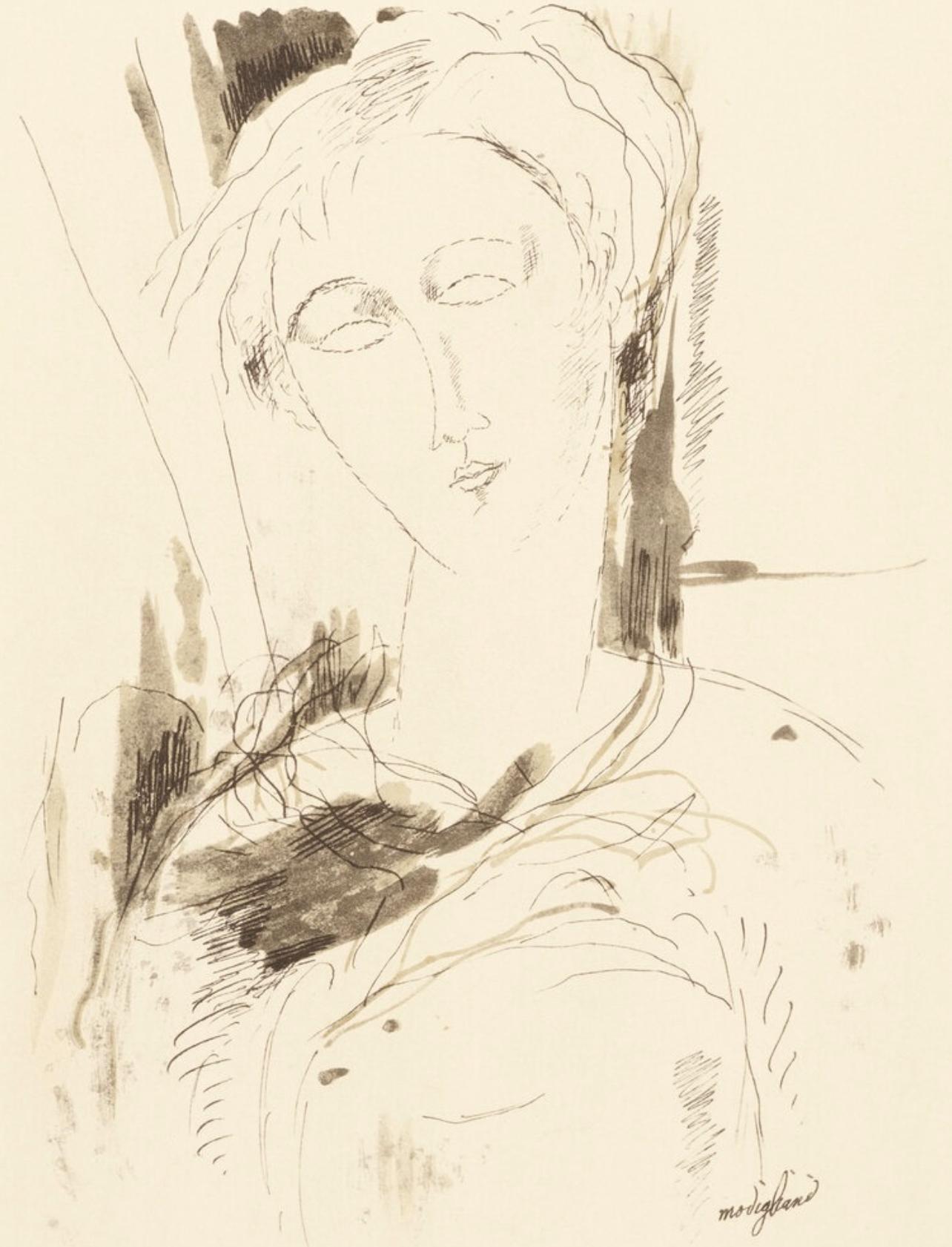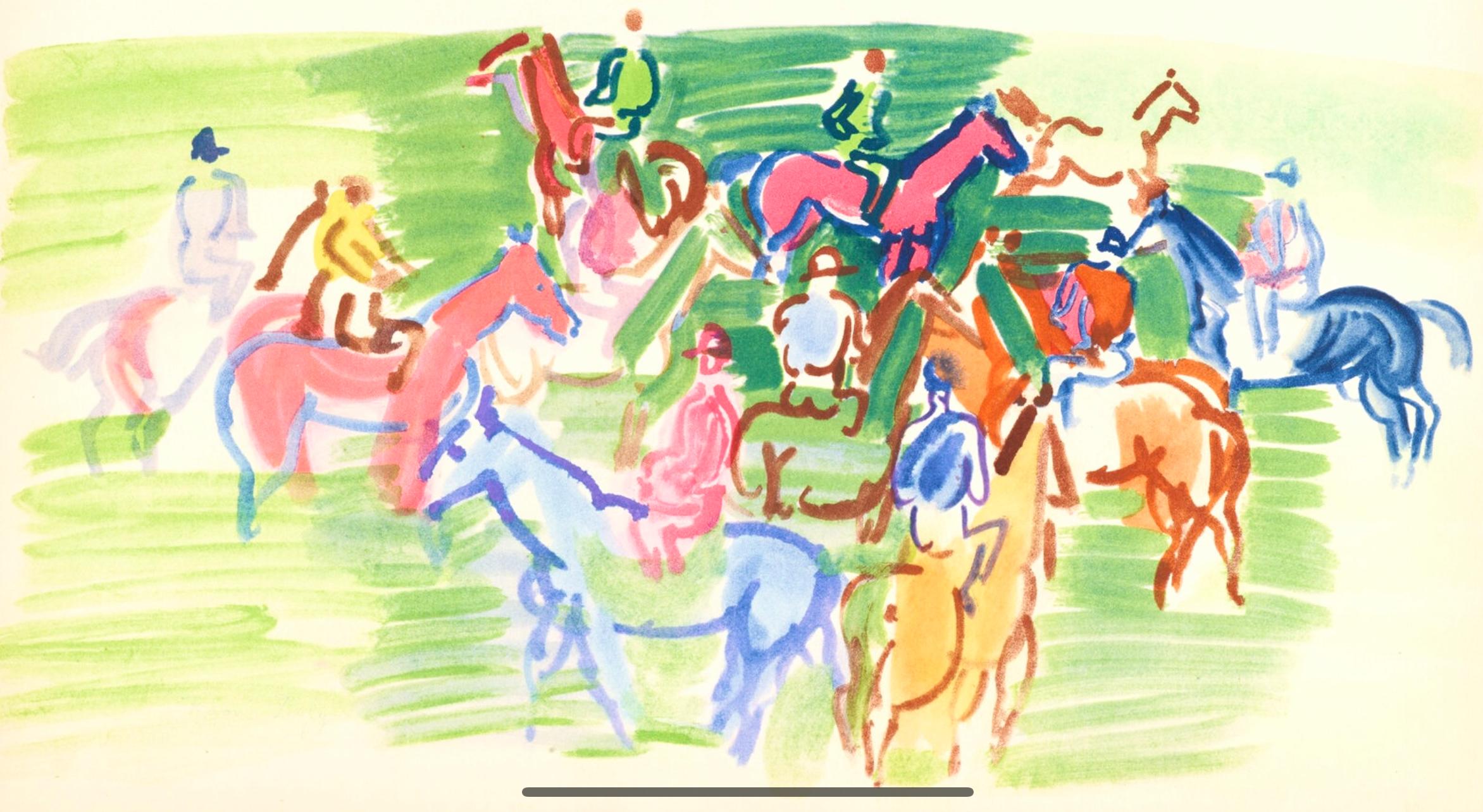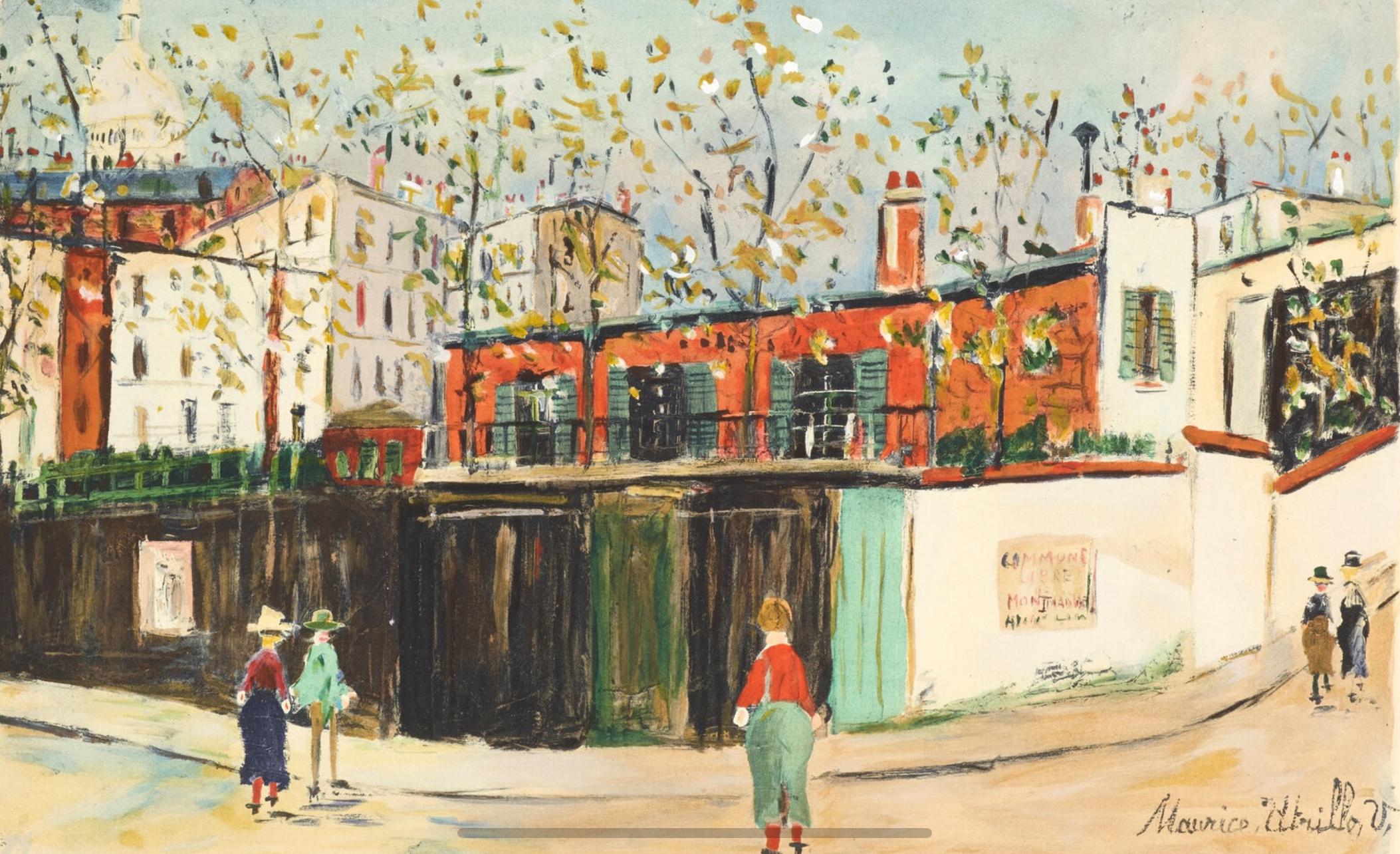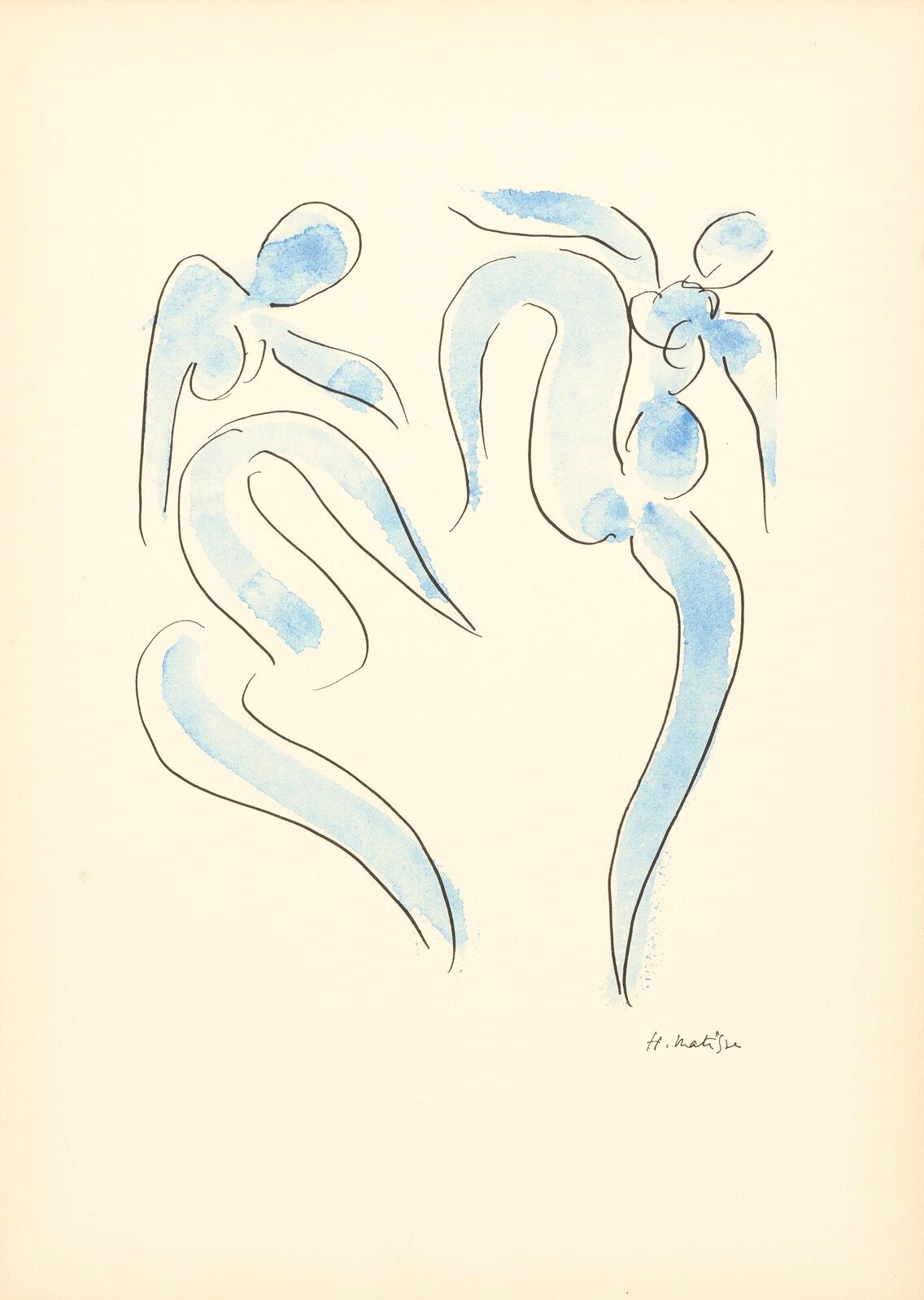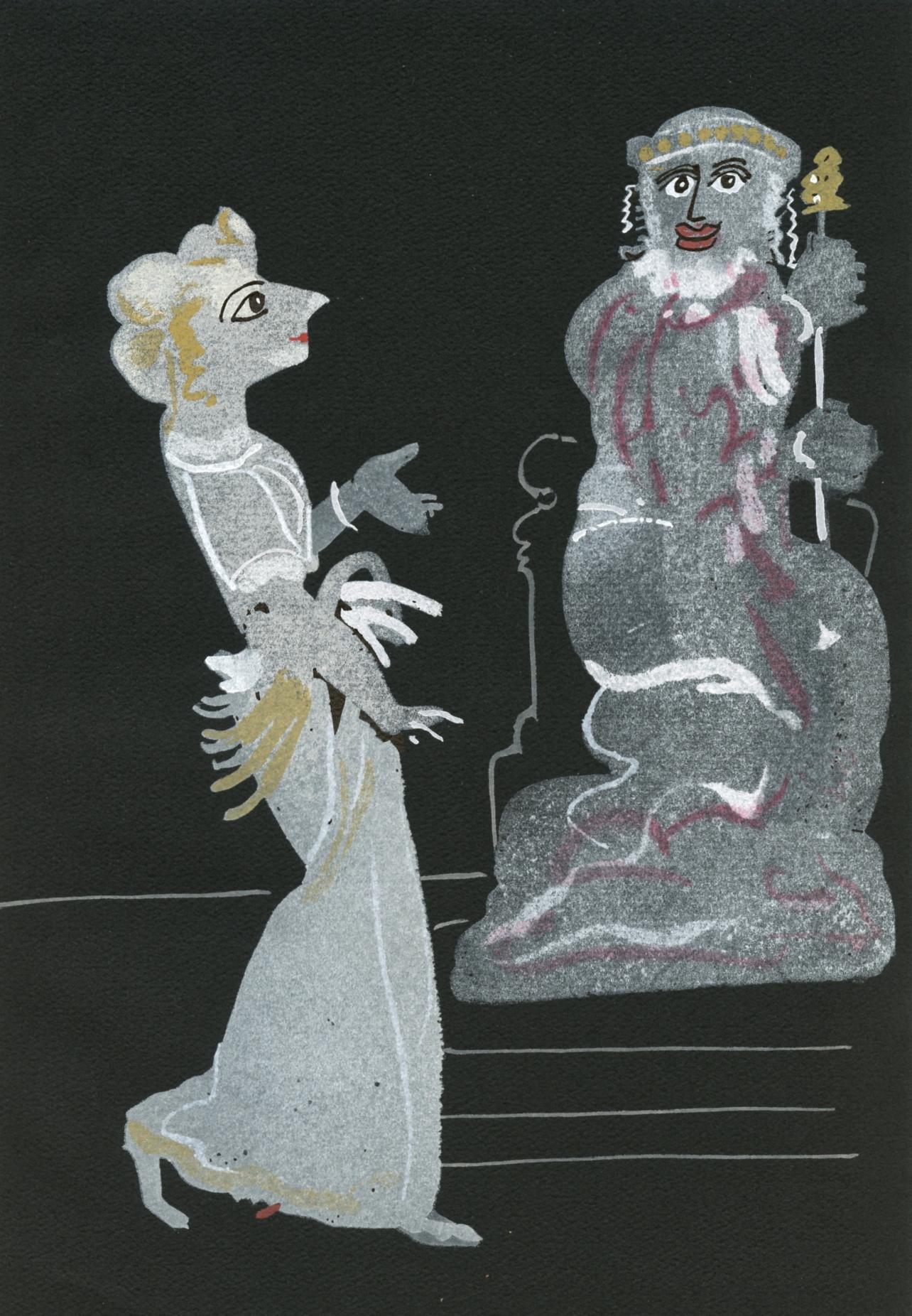Items Similar to Derain, Composition, Salomé, The Limited Editions Club (after)
Want more images or videos?
Request additional images or videos from the seller
1 of 8
Derain, Composition, Salomé, The Limited Editions Club (after)1938
1938
About the Item
Lithograph, Stencil on wove paper. Inscription: Unsigned and unnumbered. Good condition. Notes: From the volume, Salomé published by The Limited Editions Club, Paris; rendered by Jean Saudé, Paris; printed by Dehon et Cie, Faubourg-Saint-Denis, Paris, 1938. Excerpted from the volume, This edition of Salomé, printed in the original French as Oscar Wilde wrote it, consists of fifteen hundred copies for the members of the Limited Editions Club. It is designed by René Ben Sussan and printed by Dehon et Cie. In the Faubourg-Saint-Denis, Paris, the type being a new face designed by A.M. Cassandre, called Peignot and set by hand. The illustrations are gouache drawings on black paper by André Derain
reproduced through the pochoir process by Saudé in Paris. Excerpted from The Monthly Letter of The Limited Editions Club, July 1938, Number 110, On the left bank of the river which winds through Paris, behind the Boulevard Saint-Germain upon the sidewalks of which the French artists and American tourists sip their apéritifs and watch other French artists and other American tourists passing by, there is an historic little street. It is not a street in the broad sense at all, it is a narrow alley not twenty paces long, comprising two pairs of houses, their facades stained by the centuries, facing each other over cobbled stones worn smooth by the centuries. It is called the Cour de Rohan. You go into the second house on the right through a door which opens directly upon an chormous room; a room with a worn board floor, high ceilings, windows which look out on the cobbled stones, and no furniture whatever, not a chair not a table not a lamp, only a great artist's castle and a flat low model's throne. In this room Messieurs Danton and Marat met to plan the overthrow of the French aristocracy. In this room Monsieur Guillotin spread a paper over a desk and sketched the efficient machine which later cut off the heads of the French aristocracy. And in this room we cm-barked upon the exciting adventure of creating for you our members a new edition of Salomé. We dian't know at the moment that it would prove an exciting adventure; we didn't know, when we first told you about it in the prospectus for our Ninth Scries, how exciting the adventure would prove. This month your copy of Salomé is going to you and we now tell you about the adventure. It was André Derain who started it. He is an enormous hulk of a man. He is one of the most famous painters in the world. But he was not intended to be. He was born in 188o, in a little place called Chatou near Paris. His father was a superlative pastry cook, who therefore intended André to be an engincer. But, when André was only nine-teen, he met Maurice de Vlaminck, a man thirty years his senior who proceeded to interest him in painting and in painting like Cézanne. He went to Paris to study, and for years turned out paintings under the influence of Gauguin and Van Gogh and Cézanne. The art critics now call this his Gothic period, for he used the color schemes of the Gothic era and the Italian primitives such as Giotto and Cimabue. But then he came into contact with the works of Matisse and Picasso and their friends. These painters were called les fauves, because even their followers thought of them as wild animals. After the war, however, he broke away from their influence and came under the spell of the art of Renoir. Derain is now considered a painter whose design is rhythmical and finely balanced, with a range of color deliberately restricted. There have been exhibitions of the paintings of André Derain in New York and Cincinnati and Chicago as well as in all the principal cities of Europe. There have been nine books written about his life and works, one by Elie Faure in 1923. At this moment, his paintings are in even greater demand than the paintings of Picasso and Matisse. These paintings are hung in nearly all the principal mu-scums of the world. And Monsieur Derain has also illustrated books. That is why we went to see him, in his bare and historic studio in the Cour de Rohan. We wanted him to illustrate Prosper Merimée's Carmen, because we wanted him to make pictures of the female figure. He didn't like that idea, he said he was not interested in the period and the costumes required for a series of proper illustrations to Carmen. Then we suggested twelve other books. Then he suggested fourteen other books. Suddenly there was a dramatic pause, he lifted his enormous bulk off the window sill, he pointed a portentous finger at us, and he said: Salomé. So we said All right, little knowing the excitement of the adventure we were embarking upon. After we had gone through the delightful formality of signing a contract with André Derain, whereby he undertook to make a series of illustrations for Salomé by Oscar Wilde, we thought it would be a fine thing to have the edition printed in Paris, but printed in the English language. We did not know what would happen when we went across the Channel to London, to met with Holbrook Jackson. Mr. Holbrook Jackson is a kindly English gentleman, who edits a chain of trade papers for the world of the nineteen thirties but himself lives in the eighteen nineties. He is an authority upon the 'nineties, he knows with exactly what impatience John Lane greeted Aubrey Beardsley when Beardsley came to see him in his new shop in Vigo Street; he knows exactly how Oscar Wilde turned his back when he passed the Marquis of Queensberry in the street. His own book about the eighteen nineties is fascinating reading. We went to him, to ask him to write an introduction for our edition of Salomé. Before we left him, we knew more about the writing of Salomé than we ever thought we would know. We will tell you what we learned: When Oscar Wilde wrote Salomé, he was at the height of his powers. The year was 18g1, a year in which he published four books, The Picture of Dorian Gray, Intentions, Lord Arthur Savile's Crime and A House of Pomegran.
ANDRE DERAIN (1880-1954) had a major role in the development of two of the most significant artistic movements of the early-20th century. He, Henri Matisse, and Maurice de Vlaminck were responsible for generating works with a totally new style which would become Fauvism and his association with Pablo Picasso and Georges Braque was integral to early Cubism. Nevertheless, his contribution as the generator of the ideas behind these movements is constantly debated, and some consider his work derivative. This is due in part to the fact that, continually in search of artistic meaning and attempting to create a timeless art removed from the specificity of the modern age, he experimented with different stylistic idioms. Whichever side of the Derain debate you end up on, we can all appreciate his use of expressive vibrant color, his simplification of form, and his fascination with primitive art were constants throughout his work and played a major role in the creation and propagation of early Modern Art.
- Creation Year:1938
- Dimensions:Height: 11 in (27.94 cm)Width: 7.5 in (19.05 cm)
- Medium:
- Movement & Style:
- After:André Derain (1880-1954, French)
- Period:
- Condition:
- Gallery Location:Auburn Hills, MI
- Reference Number:1stDibs: LU1465214327422
About the Seller
4.9
Gold Seller
These expertly vetted sellers are highly rated and consistently exceed customer expectations.
Established in 2002
1stDibs seller since 2021
865 sales on 1stDibs
Typical response time: <1 hour
- ShippingRetrieving quote...Ships From: Clinton Township, MI
- Return PolicyA return for this item may be initiated within 1 day of delivery.
Auctions on 1stDibs
Our timed auctions are an opportunity to bid on extraordinary design. We do not charge a Buyer's Premium and shipping is facilitated by 1stDibs and/or the seller. Plus, all auction purchases are covered by our comprehensive Buyer Protection. Learn More
More From This SellerView All
- Derain, Composition, Salomé, The Limited Editions Club (after)By André DerainLocated in Auburn Hills, MILithograph, Stencil on wove paper. Inscription: Unsigned and unnumbered. Good condition. Notes: From the volume, Salomé published by The Limited Editions Club, Paris; rendered by Jea...Category
1930s Modern Abstract Prints
MaterialsLithograph, Stencil
- Derain, Composition, Salomé, The Limited Editions Club (after)By André DerainLocated in Auburn Hills, MILithograph, Stencil on wove paper. Inscription: Unsigned and unnumbered. Good condition. Notes: From the volume, Salomé published by The Limited Editions Club, Paris; rendered by Jea...Category
1930s Modern Abstract Prints
MaterialsLithograph, Stencil
- Matisse, La danse, Douze Contemporains (after)By Henri MatisseLocated in Auburn Hills, MILithograph, stencil on wove paper. Inscription: Unsigned and unnumbered. Good condition. Notes: From the folio, Douze Contemporains, 1959; published by Éditions d'Art du Lion, Paris;...Category
1950s Modern Abstract Prints
MaterialsLithograph, Stencil
- Utrillo, Montmartre, Douze Contemporains (after)By Maurice UtrilloLocated in Auburn Hills, MILithograph, stencil on wove paper. Inscription: Unsigned and unnumbered. Good condition. Notes: From the folio, Douze Contemporains, 1959; published by Éditions d'Art du Lion, Paris;...Category
1950s Modern Abstract Prints
MaterialsLithograph, Stencil
- Dufy, Paddock, Douze Contemporains (after)By Raoul DufyLocated in Auburn Hills, MILithograph, stencil on wove paper. Inscription: Unsigned and unnumbered. Good condition. Notes: From the folio, Douze Contemporains, 1959; published by Éditions d'Art du Lion, Paris;...Category
1950s Modern Abstract Prints
MaterialsLithograph, Stencil
- Modigliani, Portrait, Douze Contemporains (after)By Amedeo ModiglianiLocated in Auburn Hills, MILithograph, stencil on wove paper. Inscription: Unsigned and unnumbered. Good condition. Notes: From the folio, Douze Contemporains, 1959; published by Éditions d'Art du Lion, Paris;...Category
1950s Modern Abstract Prints
MaterialsLithograph, Stencil
You May Also Like
- Oceanic Batik, 1926 - Original LithographLocated in Paris, FRE.H. Raskin Oceanic Batik, 1926 Original lithograph and stencil Printed signature in the plate On paper, 37,5 x 27,5 cm (c. 14,7 x 10,8 inch) INFORMATION : This lithograph is part ...Category
1920s Art Deco Abstract Prints
MaterialsLithograph, Stencil
- Oceanic Flowers, 1926 - Original LithographLocated in Paris, FRE.H. Raskin Oceanic Flowers, 1926 Original lithograph and stencil Printed signature in the plate On paper, 37,5 x 27,5 cm (c. 14,7 x 10,8 inch) INFORMATION : This lithograph is par...Category
1920s Art Deco Abstract Prints
MaterialsLithograph, Stencil
- Rare Israeli Surrealist Judaica Abstract Lithograph Naftali BezemBy Naftali BezemLocated in Surfside, FLFine lithograph on deckle edged French Arches paper. Pencil signed and numbered from edition of 150. A Surrealist Judaica scene of a bearded man (Rabbi) in a boat with Shabbat candlesticks. with blindstamp from Editions Empreinte in Paris, France. (They published, Jean Michel Folon, Sempe, Raoul Ubac, Raymond Savignac, Cesar, Bengt Lindstrom , Paul Aizpiri and many other modern masters. Naftali Bezem (Hebrew: נפתלי בזם; born November 27, 1924) is an Israeli painter, muralist, and sculptor. Bezem was born in Essen, Germany, in 1924. His early adolescence was spent under Nazi oppression, in constant fear for the safety of his parents, who perished in the Holocaust in the Polish Auschwitz concentration camp. Naftali emigrated to Mandate Palestine in 1939, at the age of fourteen with a Youth Aliyah group. From 1943 to 1946, he studied art at the Bezalel Academy of Art and Design in Jerusalem with Israeli painter Mordecai Ardon. He then spent three years studying in Paris.His most famous public works include a wall relief at Yad Vashem in Jerusalem and the ceiling mural in the main reception room at the President's Residence, Jerusalem.In 1957, Bezem was a co-recipient of the Dizengoff Prize for Painting. Group Exhibitions Orit Art Gallery, Tel Aviv Artists: Yosef Zaritsky, Marcel Janco, Lea Nikel, Robert Baser, Bezem, Michael Druks, Israeli Painting (Watercolors and Gouache) Artists: Pinchas Abramovich, Bezem, Naftali Nachum Gutman, Haim Gliksberg, Mordechai Levanon, Avigdor Stematsky, Avshalom Okashi, Yehiel Krize...Category
20th Century Modern Figurative Prints
MaterialsLithograph
- Large Venezuelan Jewish Modernist Lithograph Menorah JudaicaBy Marius SznajdermanLocated in Surfside, FLMarius Sznajderman was a painter, printmaker and scenic designer living and working in the United States. Born in Paris, France in 1926 his Jewish parents had migrated to France from Poland in 1923. In November 1942 the family fled Nazi-occupied France for Spain before settling in Caracas, Venezuela. He attended the School of Fine Arts in Caracas where his teachers included illustrator Ramon Martin Durban, scenic designer Charles Ventrillon-Horber and painter Rafael Monasterios. and immigrated to the United States in 1949, where he received a Bachelor of Fine Arts and Master of Fine Arts from Columbia University in New York. He settled in Hackensack, New Jersey, where he lived and had a studio for more than 50 years before moving to Amherst, Massachusetts in 2015. His work, which includes painting, prints and collages, as well as set designs, is in more than 45 museum and public institution collections in the United States, Latin America and Israel. He held more than 40 solo exhibitions at galleries and museums and participated in more than 75 group shows around the globe. He helped found the Taller Libre de Arte, an experimental workshop for the visual arts, sponsored by the Ministry of Education. The Taller Libre de Arte was a center for young artists to work and to meet with critics and intellectuals to discuss avant-garde ideas and artistic trends from Europe and Latin America. Among the notable artists who participated in the Taller Libre de Arte were Ramón Vásquez Brito, Carlos González Bogen, Luis Guevara Moreno, Mateo Manaure, Virgilio Trómpiz...Category
20th Century Modern Figurative Prints
MaterialsLithograph
- French Modernist Mourlot Lithograph Vintage Air France Poster Roger BezombesBy Roger BezombesLocated in Surfside, FLVintage French Travel Poster, Air France Roger Bezombes (1913-1994) French Bezombes was a painter, sculptor, medalist, and designer. He studied in Paris, at the École des Beaux-Arts, and was much influenced by his friendship with Maurice Denis. Heavily influenced by surrealism, He worked principally as a painter, adopting the saturated Fauvist colors of Henri Matisse in landscapes and figure studies often based on observation of “exotic” cultures, notably Mediterranean and North African. Constrained, because a very young orphan, to all kinds of professions which provide him with the material means to devote himself to painting - he participated in 1930 in the installation of the exhibition of the Bauhaus at the Grand Palais-, Roger Bezombes is student of the National School of Fine Arts in Paris. (Ecole des Beaux Artes) He was trained in the art of fresco by Paul Baudoüin, René Barotte nonetheless restores that the young man's preference goes to the practice of "truancy" which he uses to make copies at the Louvre Museum. It’s the time when Paul Gauguin’s paintings, Vincent Van Gogh and Henri Matisse are revealed to him by Maurice Denis with whom he will remain close until his accidental death, painting him on his funeral bed on November 14, 1943. He executed surrealist tapestry designs for Aubusson and Gobelin tapestries, posters (winning the Grand Prix de l'Affiche Francaise in 1984), costumes and sets for ballets at the Metropolitan Opera House in New York, reliefs and murals. In 1965 he took up medal-making, expressing in his numerous metallic works for the Paris Mint that obsession with found objects which is also evident in his large-scale sculpture and in his posters. He designed posters for Air France and for the French national railways. Roger Bezombes went to Africa for the first time in 1936 thanks to a travel grant and received the same year the second grand prize of Rome . In 1937 he traveled around Morocco where he became friends with Albert Camus. The year 1938 offered him both his first solo exhibition at the Charpentier gallery in Paris with paintings and gouaches on the theme of Morocco and the attribution of the national grand prize for the arts, earning him a great journey which , from Dakar to Algiers , takes it through Chad , Tamanrasset and Hoggar. Roger Bezombes became a professor at the Julian Academy in 1950. For him, 1951 was the year of a trip to Greece and the year where he began his relationship with tapestry work. Roger Bezombes visited Israel in 1953, Tunisia and Egypt in 1954. He was appointed official painter of the Navy in 1955. Pierre Mazars analyzes that “after a period where we notice the influence of Van Gogh and GeorgesBraque, particularly in his landscapes of Provence, he came to a more schematic writing, the colored spots and the thicknesses of material taking more of importance as the subject. He even performed composite works, half-watercolors, half-pasted papers, in which he incorporated pieces of newspapers”. He was elected titular to the Academy of Overseas Sciences in 1978. "The range of Bezombes' talent forms is remarkable,” writes Lynne Thornton, “ranging from paintings, murals, travel posters, tapestry cartons, book illustrations, monumental ceramic decorations, ballet and theater sets, totem sculptures, sculpture objects, jewelry and medallions”. He was part of the mid century mod School of Paris that included Leon Zack, Bernard Lorjou, Paul Augustin Aizpiri, Gabriel Godard, Michel Henry, Hans Erni, Bengt Lindstrom, Alfred Manessier, Andre Hambourg, Raymond Legueult and Jean Rigaud. Select Solo Exhibitions: 1938: Galerie Charpentier, Paris 1950, '53, '55, '57: Galerie Andre Weil, Paris 1953:Wildenstein Gallery, London 1954: Institut Francais, Cologne 1956: Galerie Matarasso, Nice 1957: Horn Gallery, Luxembourg; Guilde de la Gravure, Paris 1958: Denys-Puech Museum, Rodez 1962: Musee de l'Athenee, Geneva; Chateau Grimaldi, Cagnes-sur-Mer 1966: Galerie des Ponchettes, Nice 1967: Galerie Martel, Montreal 1968: Romanet-Vercel Gallery, New York; Reattu Museum, Arles; Le Corbusier Center, Firminy 1969: Galerie Philippe...Category
1980s Modern Abstract Prints
MaterialsOffset, Lithograph
- Pablo Picasso Estate Hand Signed Fauvist Lithograph Woman Portrait Marie ThereseBy (after) Pablo PicassoLocated in Surfside, FLPablo Picasso (after) "Portrait de Marie Therese" limited edition print on Arches paper, Hand signed by Marina Picasso lower right and numbered 274/500 lower left From the estate of Pablo Picasso with an embossed blindstamp in the lower right side of the piece. After Pablo Picasso's death in 1973, his granddaughter Marina authorized the printing of these original lithographs, which have come to be known as the Picasso Estate Collection. The lithographs were meticulously created after the original works (Oil Paintings, Watercolors, Pastels, Charcoal Drawings, etc.) by Master Chromist Marcel Salinas, who worked closely with Picasso in his lifetime. They are printed in an edition of 500 on Arches paper. Embossed with the estate and chromist's stamp seals, along with the legend on the reverse "Approved by the heirs of Pablo Picasso". Image: 19 1/2" x 15". Paper: 28" x 20 3/4". Pablo Ruiz Picasso (1881 – 1973) was a Spanish painter, sculptor, printmaker, ceramicist, stage designer, poet and playwright who spent most of his adult life in France. Regarded as one of the most influential artists of the 20th century, he is known for co-founding the Cubist movement, the invention of constructed sculpture, the co-invention of collage, and for the wide variety of styles that he helped develop and explore. Among his most famous works are the proto-Cubist Les Demoiselles d'Avignon (1907), and Guernica (1937), a dramatic portrayal of the bombing of Guernica by the German and Italian air forces during the Spanish Civil War...Category
20th Century Modern Abstract Prints
MaterialsLithograph
Recently Viewed
View AllMore Ways To Browse
The Stone By The Door
Picasso Signed Sketch
Picasso The Artist And His Model
John Andre
Picasso Costume
Le Fauves
Vintage Furniture Stencils
House Number Window
Van Gogh Book
The Painter And His Model Picasso
Vintage Sidewalk
Vintage Watches London
Vintage Pastry
Period Fauvism Painting
Painting Andre Derain
Set Matisse Prints
Vintage Doors And Windows
Set Of Nine Prints
